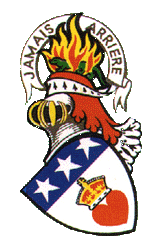I have included this article as there is a heart in the
arms - and I note the use of Douglas as a Christian name of the clan
chief, as did his grandfather, John Douglas Houison Craufurd of Craufurdland and Braehead.
I have not found any marriage links between the Craufurds and the
Douglases since Sir Archibald (2nd of Douglas & of Hermiston) Douglas,
4th Lord Of Douglas, who died in 1240, married Margaret De Crawford, Of
Crawford.
1, 2 & 3. Tapestry covered
chairs. Each one contains the quartered arms of Craufurd (in the
first and fourth quarters) and Howison (in the second and third
quarters), with the crest and motto of each family
4. This is
the reverse side of a flag, so the quarters are reversed, with Howison
in the first and fourth quarters and Craufurd in the second and third.
While the lettering of the mottos is correct, t seems that for the rest
the artist simply followed the patterns he could see from the obverse
rather than placing the quarters in their expected places. (You might
notice too that the couped hand crest of the Howisons is painted here as
a sinister hand rather than a dexter one; again, the reverse of what it
should be.)
We were told that this side of the flag is displayed
because the front side is much more deteriorated than this side is.
5. Two painted coats of arms, with crests and mottos, are on the
back of a bench. The coat of arms on the left is the arms of Howison:
Crawford to the right.
6. The Howison family arms on a plaque
7 & 8. A basin
and ewer set, the crest on the latter not shown.
The is inscribed:
In Perpetua Rei Memoria
With this basin and ewer
William Howison
Craufurd
Younger of Braehead and Craufurdland,
in place of his
mother
Mrs. Elizabeth Howison Craufurd,
rendered to
King George
the Fourth
The Ancient Servitium Lavacri,
By which tenure she
holds her Lands of Braehead.
And that by tendering to His Majesty
The Basin and Ewer with a Clean Napkin,
After He had partaken of an
Entertainment
Given by the Magistrates of Edinburgh,
in the
Parliament House of that City,
upon the Twenty Fourth of August,
MDCCCXXII [1822].
The armorial on the basin, at 8, is well
crafted.
9. The arms are blazoned in Burke's
General Armory as: Crawfurd, or Craufurd (Craufurdland, co. Ayr: the
heiress m. 1744, Howieson, of Braehand [s/b Braehead]). Gu[les] a fess
erm[ine]. Crest - A marble pillar supporting a man's heart [proper].
Motto - Stant innixa Deo. Fairbairn's Crests gives the translation of
the motto as "They stand depending upon God."
Simon Douglas
Houison Craufurd of Craufurdland and Braehead is the 29th laird. He is
married to Adity Priyadarshini, and they have two daughters, Indra and
Manisha.
Of the Howison arms, Burke says: Howison (Braehead, co,.
Midlothian; now [this is the 1884 edition of Burke] represented by
Howison Craufurd, of Craufurdland, co. Ayr, and of Braehead, co.
Midlothian). Ar[gent] a man's heart gu[les] on a chief az[ure] three
fleurs-de-lis or. Crest - A dexter hand couped apaumée [proper]. Motto -
Sursum corda. Once again, we turn to Fairbairn's Crests for the
translation: Hearts upward.
_small.jpg) Craufurdland
Castle is a rebuilt tower house, originating in the 16th-century, about
2.5 miles (4.0 km) north east of Kilmarnock, East Ayrshire, Scotland,
north of the Craufurdland Water. Craufurdland
Castle is a rebuilt tower house, originating in the 16th-century, about
2.5 miles (4.0 km) north east of Kilmarnock, East Ayrshire, Scotland,
north of the Craufurdland Water.
The property belonged to the
Crawfords from the 13th century. John Crawford of Craufurdland was
killed at the battle of Flodden in 1513. The castle was built in the
16th century, remodelled and extended in the 17th century, and further
extended in the 18th and 19th centuries. Ownership passed to the
Howiesons in 1793. The house was restored in the 1980s, and it is still
occupied.
Simon Houison Craufurd, 29th Laird of Craufurdland
Castle holds the role of Washer of the Sovereign's Hands in Scotland.
A corbelled-out battlement at one end of the original tower remains,
as part of the west wing. This is three storeys and an attic high. There
is a basement which is vaulted, but the interior of the tower has been
greatly altered. There is a fine plaster ceiling, dated 1668, in the
King’s Room, incorporating the arms of the Stewarts.
The
17th-century east wing is two storeys high. It is said that an
underground passage connected the castle to Dean Castle, some miles
away. The castle was remodelled as a castellated mansion, in Gothic
style. |


